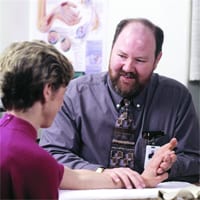Trigger Unhappy Knowing What Causes Asthma Can Help Children Minimize It
While asthma is a year-round concern for youngsters and their families, many find that their symptoms worsen every spring as the weather warms and trees and plants begin to bloom.
Springfield is well-known as one of the most asthma-aggravating cities in the U.S. Considering spring’s wind-blown tree and plant pollens — combined with all kinds of pollutants in the air, mold, and other irritants — many young patients suffering from asthma attacks will be seeking increased medical care during these ‘irritating’ months.
In Springfield, asthma is the single most chronic illness in children. According to the Centers for Disease Control, asthma is one of the most common chronic illnesses, affecting more than 20 million people nationwide. The Mass. Department of Public Health notes that asthma affects 10{06cf2b9696b159f874511d23dbc893eb1ac83014175ed30550cfff22781411e5} of children statewide, with particularly high rates in Springfield (16{06cf2b9696b159f874511d23dbc893eb1ac83014175ed30550cfff22781411e5}) and Holyoke (18{06cf2b9696b159f874511d23dbc893eb1ac83014175ed30550cfff22781411e5}). And asthma attacks account for one of the highest percentages of pediatric visits to Baystate Medical Center’s Emergency Department.
We’ve all heard the old axiom that ‘knowledge is power,’ and the same holds true when managing your child’s asthma. Understanding how and when asthma causes problems for your child, what triggers an attack and how to avoid those triggers, and how and when to use medications can quite literally mean life or death for your child.
The most common triggers of asthma in children are colds and allergens which can cause a child’s airways to become inflamed and fill with mucus. This inflammation is thought to be what leads to symptoms of coughing and wheezing when exposed to an asthma trigger.
Parents who find that their child’s asthma and allergy symptoms start or worsen in the greener months of spring should make an appointment with a pediatrician, who may refer you to a pulmonologist or an allergist for formal testing. A pulmonary function test may also be performed to lean how air flows in and out of the child’s lungs, as well as other tests which measure inflammation. Allergy testing may reveal what substances may trigger an asthma attack. Chest X-rays, however, are not helpful in diagnosing asthma.
Common symptoms of spring allergies can include sneezing, nasal stuffiness, runny nose, tickle in the throat, coughing, difficulty breathing, tightness in the chest, and itchy, watery eyes. Antihistamines may control some of these symptoms but, by themselves, are not treatment for asthma.
Your child may have asthma if he or she has one of the following symptoms: recurrent cough, nighttime coughing, wheezing, or colds that go to the chest, or won’t go away quickly. Other symptoms may be chest congestion, chest pain, shortness of breath, and fatigue with exercise.
While there is no cure for asthma, given the various medications and treatments available today, it is quite manageable, especially if you help your child avoid what triggers their asthma.
Among the many things parents can do this spring to help keep their children’s allergies and resulting asthma attacks under control are:
- Avoid being outdoors during the morning hours from 5 to 10 a.m., when the pollen count is peaking. The best time to participate in outside activities is following a rainfall, which washes pollen away.
- Wear a face mask while performing outside activities such as raking or mowing.
- Shower and wash hair immediately after coming in from outside activities, especially before going to bed. This will remove any pollen on the skin and hair. Also, wash all clothing that was worn outside in hot water.
- Keep the windows and doors of your home and car closed. An air conditioner should be used to cool the air, not window or attic fans.
- Although warm, moist air from vaporizers can greatly ease nasal stuffiness, living in damp houses is not healthy. Dust mites thrive in humidity, and damp houses increase the risk for mold, and as a result ongoing humidifiers can be counterproductive.
- Avoid hanging sheets or clothing out to dry on a clothesline. Pollen can collect on these items.
- Avoid irritants that could aggravate your child’s symptoms, such as tobacco smoke, cleaning chemicals, perfumes, and air fresheners. On hot, humid days in the summer, air pollution can be trapped at ground level, which also can trigger an asthma attack. Meanwhile, insect sprays can be an asthma trigger if inhaled into the lungs.
Modern medications to prevent asthma attacks suppress the inflammation in the lungs, but cannot cure asthma. Taking prescribed medications every day is important, but avoiding triggers is equally important. Too many people stop their medications just because they feel well. Doing this, however, will fail to keep asthma under control, and as a result, the child may end up visiting their local emergency department.
Finally, part of being knowledgeable about childhood asthma is developing an asthma-management plan with your child’s pediatrician, pulmonologist, or allergist. A written asthma-action plan at home can be your guide to good self-management of asthma. With proper medication, asthma can be controlled so children can lead normal, active lives, without having to suffer from frequent asthma attacks.
For more information on asthma, or for a referral to a physician, call Baystate Health Link at (800) 377-4325, or visit baystatehealth.org and click on Baystate Children’s Hospital, Pediatric Specialties, and then Pediatric Pulmonology.
Dr. Robert Kaslovsky is chief of Pediatric Pulmonology at Baystate Children’s Hospital.



Comments are closed.